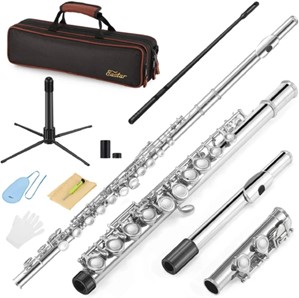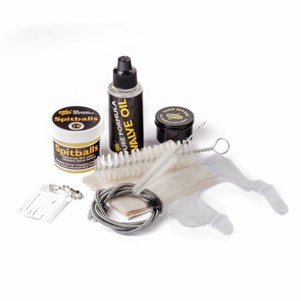History
It’s fascinating to know that the flute is considered one of the oldest musical instruments. A flute made of bone, dating back 19,000 years and carved from the bone of a deer, was discovered in vineyards north of Krems an der Donau (Lower Austria).
During the Renaissance, the flute gradually emerged as a distinct musical instrument from the recorder. The Renaissance flute was made from a single piece. In the Baroque period, the transverse flute was constructed in three parts. In the Classical period, the flute gained additional keys.
The real innovation in flute construction occurred after the Classical period, thanks to Theobald Boehm (1794-1881). This flutist and instrument maker gave the flute its present form. In 1832, Theobald Boehm developed a chromatic key system, taking into account the placement of tone holes based solely on acoustic principles. Historians agree that this system also served as a model for the clarinet. However, Theobald Boehm was not the first or the last to design a flute. In the last 160 years, the flute remained unchanged, with few attempts to modify it. For example, Louis Dorus (circa 1860), Rudall Carte Co. (circa 1860), Otto Schwedler (circa 1890), and Alexander Murray (circa 1960) attempted to improve Boehm’s design, aiming for a flute with greater technical capabilities, a wider dynamic range, and a vocal spectrum. However, Boehm’s design, both complex and elegant, flexible, and easy to play, remained the basic model in modern flute construction.
Theobald Boehm was also responsible for introducing the use of metal. Wooden flutes were still widely used until the early 20th century, but his key system brought many improvements. The opening and diameter of the tone holes were no longer limited by the size of the musician’s hands and fingers. All keys could reach the range of an average player, the sound quality improved, and the flute could now affirm its position in the orchestra.
The Parts
In the standard flute, the body is straight and divided into three pieces. However, there are flutes with a curved shape, such as the alto and bass flute. The body parts can be constructed from various materials. On the upper piece, there is the inlet hole for the incoming air. By placing your lower lip comfortably and blowing into the flute, you guide the airflow in a similar way to blowing into a bottle neck. At the end of it is the crown. Inside this detachable piece is the cork, which is not visible externally. To ensure proper tuning of the flute, the cork must be in the correct position.
The sound of a flute depends mainly on its parts and the material of construction. A good silver flute has a more complete and high-quality sound. The nobler the metal used, such as silver or gold, the fuller and more circular your sound will be. However, each piece resonates differently in each flute. There are also various sizes, such as the piccolo flute. If needed, you can seek advice from our specialized department. We will be happy to guide you and find together what truly suits you.

The central part of the body is equipped with many keys that are also called buttons. These keys control the air in the instrument and are responsible for the tonality.
Regarding the key systems, there are two types of constructions:
Inline Configuration:
- Keys arranged in a line are referred to as an inline setup.
- If the G key is moved towards the left-hand, then we have the offset G model (also known as Inline/Offset).
- Types of Keys:
- Closed Keys/Holes (Closed Type): Fingers press the keys, and these, in turn, close the holes of the tone.
- Open Keys/Holes (Open Type): Keys for open holes, also known as a flute with rings (more on this later in this guide).
The last and smallest part features keys for the lower tones. Most flutes have 13 large and 3 small tone holes. Most holes are closed by the fingers during play. They usually also have 16 keys that, when pressed, close the tone holes.
Key Types - Open or Closed Type
Most professionals play the flute with open keys, meaning open type. Flutes with open keys have the advantage that the flutist feels the flow of air on the edges of their fingers, allowing for a better sense while playing. Additionally, a system with open keys requires a more precise finger technique, which positively affects flute playing, but it is also much more challenging to adapt to and learn. For this reason, beginner flutes are usually of the closed type, as the goal here is the easy adaptation of the student to a new wind instrument, providing more immediate results and greater ease in playing.
During the purchasing process, you have the option to choose between open or closed types. If you choose an open-type flute, your flute will have 5 keys with open holes on the upper side. Your fingers should cover these holes exactly, and this is not always easy. Playing is clearly more challenging in this case, but it forces you to adopt the “correct” finger position during reproduction. Specifically, your left finger must stretch quite a bit, especially if you have small hands and your flute does not have an Offset G. Flutes with closed keys are easier to play.
Split E Mechanism
Many flutes, especially in the beginner category, come equipped with the Split E mechanism. In flutes without this mechanism, playing the high E (e3) can be a bit challenging. The Split E mechanism significantly improves the response and makes the instrument more user-friendly. You can recognize if a flute has this mechanism by the additional lever between the second G key and the F# key. This lever closes the second G key when you play the high E.
If you play a high E on a flute without the Split E mechanism, the second G key remains open. Most professional flutists tend not to use the Split E mechanism, as they can achieve these notes with good technique even without it. However, the Split E mechanism is considered very important in beginner and intermediate flutes for facilitating the production of high E more easily.
Construction Types - Inline or Offset-G
As mentioned earlier, there are two basic construction types: Inline and Offset-G. In the inline type, the keys are arranged in a straight line on the body of the flute, while in the Offset-G type, the G-SOL keys are slightly offset from the line. The idea behind the Offset-G is that the G keys are slightly forward, making them easier for the fingers to reach. In the first category, the G keys align with the flute’s holes. In these, the left hand’s fingers may need to stretch a bit more and be placed precisely on the key, especially in the case of open-hole flutes with rings. As for the sound, there is no significant difference between playing a flute with Inline or Offset-G construction.
Materials of Construction
Until the revolutionary design by the renowned flutist Theobald Boehm in 1847 (the cylindrical Boehm flute), flutes were primarily made of wood. The first gold flute appeared in 1869, crafted by Louis Lot. Today, flute construction involves various materials, such as gold-plated silver, white gold, nickel, silver (with copper, phosphor bronze, and nickel alloys), platinum, palladium, nickel, titanium, carbon, copper alloys, and stainless steel.
For beginners, more affordable instruments are usually made from materials like silver-plated or sterling silver aluminum, or other less expensive metals. Wooden flutes (using the Boehm system) have gained popularity in recent years and are used in major symphonic orchestras.
In the 1990s, flute manufacturers began crafting instruments from carbon fiber. These instruments have some advantages in terms of durability and maintenance compared to metal flutes, but they are somewhat controversial due to their tonal characteristics, which deviate from the “normal” flute sound.
Cleaning and Maintenance
Maintenance and cleaning for all wind musical instruments are essential processes for both the proper functioning of the instrument and the hygiene of the person using them. For this reason, there are special cleaning and maintenance sets from Herco to keep your musical instrument always clean and in optimal playing condition. Find a wide variety of cleaning products for wind instruments on our website www.musicpower.gr to keep your flute always in excellent condition.
The flute has a delicate mechanism that requires lubrication and adjustment at regular intervals. Pads under the keys should be replaced when they wear out. Also, it is essential to avoid leaving the flute assembled and exposed outside its case for an extended period, as it may collect dust or even rust. Additionally, do not store cleaning cloths inside the flute case, as this can lead to the accumulation of dust on the flute faster, and the pads may absorb moisture and become damaged.

Tips:
- For drying the flute from internal moisture, clean it with a well-washed cotton cloth.
- Never store the cloth together with the flute in the case, unless the case has a separate compartment for it.
- When taking a break from playing, put the flute back in its case. It’s the safest place for it. The keys won’t get dusty, and it can maintain its shine.
- Never place the flute near heat sources, as heat can dry out the oil or coating and affect the key mechanism.
- Typically, a check-up by specialized personnel once a year is sufficient.
- If the keys of the flute stick and do not return to their initial position after pressing, you can gently place a piece of paper under the key and then press the key several times to gather moisture on the paper. If you sweat a lot or have a “wet” breath, the keys may stick more often, and you may need to repeat the cleaning process.
- Clean your teeth and wash your hands before playing.
- A new flute should be fully checked and adjusted after one year. A good flute should be professionally maintained every five to ten years. In any case, be sure to clean the instrument carefully and lubricate the key mechanism.
Conclusion
The flute can serve as a versatile instrument that can be played and heard in classical music orchestras as a solo instrument, as well as in alternative music genres such as pop, rock, and even jazz.
Learning the flute is a challenging process that requires professional guidance. It involves not only acquiring the necessary finger dexterity but also understanding the techniques of embouchure and breath control. A teacher will ensure the correct posture with the instrument, as well as teach all the techniques for proper breathing.



